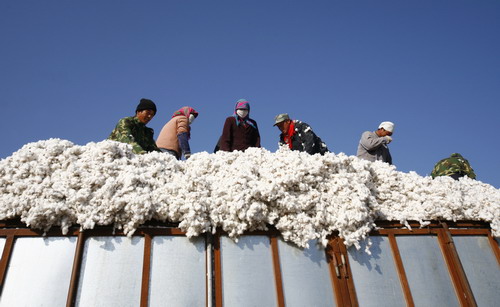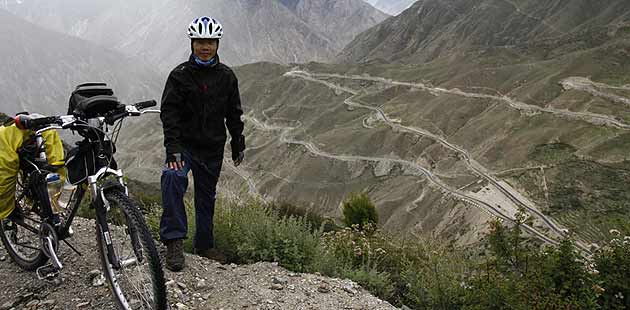Harsh harvest looms for Xinjiang cotton growers
Updated: 2011-10-11 13:31
By Shao Wei (China Daily)
|
|||||||||||
|
 Farmworkers load cotton into a truck in Hami, Xinjiang. Growers are having a hard time with the harvest because of labor shortages and the higher pay rates that workers are demanding. [Photo/China Daily] |
Enter the machines
About 1,000 mechanical cotton pickers work in the corps' fields this year, and their daily output equals 600 regular hands. Nearly half of the corps' 4,700 or so square kilometers is harvested mechanically, replacing 350,000 human pickers and cutting labor costs significantly.
The corps' general plan calls for all cotton to be picked by machines at the end of the 12th Five-Year Plan (2011-15).
However, that doesn't solve this year's labor shortage.
"The corps has more than 2,000 divisions dealing with cotton planting around Xinjiang. Compared with the big harvest demand, the number of picking machines is quite small," said Fu Deqiang, a grassroots official for XPCC who is in charge of 613 hectares of cotton and hires only 600 cotton pickers.
His cotton could have been picked in mid-September, Fu said, but he had to wait for the machines. They arrived on Saturday.
"One hectare can produce about 5,100 kilograms of cotton. But a regular hand can pick 110 kilograms a day at most, from 5 am to 10 pm," Fu said. "You can easily see that it's totally impossible for them to complete the harvest within two months."
There is an important trade-off for the labor savings. Mechanical pickers degrade cotton quality, lowering the price.
"The impurity content takes up 2 to 2.5 percent of a kilogram of handpicked cotton, while that of mechanically picked cotton amounts to 15 to 18 percent," Fu said. "On average, the price of a kilogram of handpicked cotton is 0.5 yuan higher than mechanically picked cotton."
Additionally, mechanical cotton picking requires standardization throughout the process - planting rows a consistent distance apart, for example.
"Big farmland, standardized mode of planting, expensive imported mechanical cotton picker and the matched cotton processing machine ... Each is important and necessary," Fu said.
Trying to survive
XPCC is in the earliest stages of transforming from labor-intensive to mechanical agricultural production. Meanwhile, outside farmers are trying to survive on small, uneconomical farms.
"The lint of the open cotton began falling from bolls in late September," Ding, the farmer in Shawan county, said on Sunday. "Sunshine, wind and dirt have ruined the cotton fiber and reduced nearly a quarter of the output.
"I found 30 temporary cotton pickers from the local labor market last week, and they've helped me collect one-third of my cotton," she said.
"As it's getting cold and the snow is coming, I am sure they will ask for a higher price. I have to pay. I have no other choice."
Related Stories
China's cotton import down 13.8% in Aug 2011-10-08 09:11
China launches temporary cotton reserve 2011-09-09 09:57
Cotton production set to rise for first time in four years 2011-08-26 10:56
China July cotton imports up 30.89% from June 2011-08-11 11:40
- Transport data raise privacy concerns
- Regulator to review Beijing Jingkelong IPO
- City govt fails to clean up pollution
- Letter calls Gucci stores 'sweat shops'
- City's Wal-Marts to close for 15 days
- China IPOs shrink to two-year low in Q3
- Oil, gas tax rate moves to value base
- CSR to build Melbourne HQ













